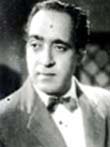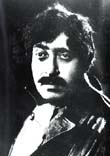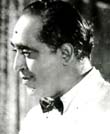V Gangadhar
 The eyebrows
rearrange themselves in a slight arch. The lips twitch
into a sneer. An aura of menace pervades as the throat is gently
cleared. And the index finger of the right hand is crooked, to
summon a nearby henchman.
The eyebrows
rearrange themselves in a slight arch. The lips twitch
into a sneer. An aura of menace pervades as the throat is gently
cleared. And the index finger of the right hand is crooked, to
summon a nearby henchman.
Film star K N Singh played the polished, sophisticated villain
in nearly all his 250-odd films. He was always immaculate in his
dress - a suit, overcoat, hat and cigarette completed his villainish
get-up.
Every time Singh entered the screen, it was clear that he was
up to no good. And he did not have to rave or rant, use abusive
language or wear garish clothes to achieve this menacing effect.
One penetrating look, a couple of hissed-out commands and everyone
on the scene would cringe. It was the moment of the villain.
This most polished of Indian villains was never tutored in the
art of acting. In fact, it was a novice Singh who faced the camera
for the first time on September 9, 1936, on the sets of Sunhera
Sansar,a Calcutta production directed by Debki Bose.
"Man does not control his destiny," mused Singh. "I
thought I would join the army, but ended up in a movie career
which lasted nearly 45 years." His brother, the late Bikram
Singh, was the distinguished editor of Filmfare for many
years.
Today, K N Singh is nearing his 90th birthday and the ravages
of age on this once-erect frame show. His mesmerising eyes are
dull. Singh's optic nerves began drying up in 1990 and his vision
is seriously affected. "Everything is hazy before my eyes,"
he says matter-of-factly. "I can't read or watch television
any more." His sight began to be affected by 1984 despite
having had two cataract operations.
The veteran actor, though, has learnt to accept this handicap
with grace. He is still highly articulate and is blessed with
an astonishing memory, evinced by the fact that he can rapidly
quote the dates, years and names of his films, their directors
and his co-stars.
Singh, today, lives in a simple flat at Bombay's Wadala Road,
just opposite the prestigious Victoria Jubilee Technical Institute.
Everyone knows him there. At my very first meeting with him, I
happened to mention the problem I had had in locating his flat
since I only had the plot number and the name of the street. "Did
you tell anyone that you were trying to find K N Singh's home?"
he asked with a smile.
"Try it tomorrow."
The next morning, just to convince myself, I asked four people
in the area the route to Singhsaab'sflat. All of them
guided me correctly! For nearly 55 years, he has been a near-legend
in the area.
 A native of Dehra Dun,
Singh was educated at both Dehra Dun and
Lucknow. His father, Chandi Prasad Singh, was one of the most
famous criminal lawyers in the region, along with Sir Tej Bahadur
Sapru. He finished Senior Cambridge with Latin as one of his subjects.
"I had plans to study Law in London," mused Singh. "A
knowledge of Latin would have been useful."
A native of Dehra Dun,
Singh was educated at both Dehra Dun and
Lucknow. His father, Chandi Prasad Singh, was one of the most
famous criminal lawyers in the region, along with Sir Tej Bahadur
Sapru. He finished Senior Cambridge with Latin as one of his subjects.
"I had plans to study Law in London," mused Singh. "A
knowledge of Latin would have been useful."
But Singh was not destined to follow in his father's footsteps.
The eldest among five brothers, he left home early and was a rolling
stone. When Singh reached Calcutta where his sister lived, he
ran into Prithviraj Kapoor, a family friend. They had common friends
and Singh had admired Prithviraj in films like Sita and
Rajrani Meera. Director Debki Bose was also present. He
suggested Singh join the film industry, offering him a role in
Sunhera Sansar.
Many producers from Bombay were filming in Calcutta in those days.
One of them, A R Kardar was making Milap, a courtroom drama,
and wanted someone to play the prosecutor's role. Kardar, when
introduced to Singh, promptly offered him the role. The dialogue,
which ran into four pages, had to be memorised within two days.
The next day, Prithviraj, who lived opposite Singh, dropped in
for a visit. "Come on," he demanded, "let me see
how you deliver your dialogue." Singh did it faultlessly.
"Dialogue tho theek hai, vakil kidar hain?" questioned
Prithviraj. Singh put on a gown and shoes and repeated the dialogue.
Prithviraj was impressed.
The next day, Singh appeared before the camera and completed the
600 feet long shot at one take. Kardar was delighted.
Bombay, meanwhile, was fast becoming the centre of the film industry.
Singh, who was under contract with New Talkies at Rs 150 a month,
informed the New Talkies boss, B N Sircar, he wanted to work in
Bombay. Sircar agreed and Singh made his switch after finishing
his pending films.
Though his family, particularly his father, did not favour a film
career, Singh did not care. "I always had an independent
mind and felt I had a future in films."
Singh reached Bombay in December 1937, to an open-arms welcome
by the film industry. He signed up with the Fazalbhoy brothers
and made films like Baghbaan, Industrial India and Pati
Patni.
"I was never considered for a hero's role," explains
Singh. But he had no cause for worry. Baghbaan, where he
played the villain, was a hit and the offers poured in. Such was
the impact of Singh's villainy that the heroes in his films were
warned what they had to contend with. After watching Singh, Yakub,
who was the leading villain in those days, confessed, "You
are not merely Singh, but a king. I will not play the villain
any more." Yakub then switched to character roles.
Those were the days of the studio system. Studio contracts stipulated
that the actors could not perform for others. Singh first worked
with the Fazalbhoys, then switched to Nanubhai Desai and finally
joined Sohrab Modi's Minerva Studios. He was paid around Rs 500
a month in his initial years.
When Devika Rani, who was in charge of Bombay Talkies, offered
Singh a contract, she asked him how he was expecting. Singh, who
respected Devika Rani very much, replied, "How can I quote
any figures to you? Pay me whatever I am worth." He was offered
Rs 1,600 a month, plus the privilege of being picked from and
dropped to his home by the studio car. He worked in three or four
films a year, mostly under top directors like Amiya Chakraborty
and Shakti Samanta.
Singh was a quick learner. He also made it a point to study his
roles thoroughly. Like he did, when he played the role of a Victoria
(horse-drawn carriage) driver in Shakti Samanta's Inspector.
"For days together," recalls Singh, "I studied
how the drivers sit, stand, talk and work. These are things no
director can teach you. When I finally enacted the role, Shakida
was highly impressed."
Singh believed that every role offered scope for creativity. "You
have to create the scope," he insists. "As a villain,
I saw to it that my very entry brought about an air of unpleasantness
and bitterness to the situation." But his villainy was never
blatant - he never overacted or screamed. There was enough menace
in the way the suave, polished, immaculately dressed Singh took
in the room as he strolled in.
At the same, Singh emphasises on variety. And he could do wonders
with a walking stick. "The way you walk, talk... should change
constantly." Singh regarded himself as a student of acting.
He read numerous books on the subject and was most impressed with
An Actor Prepares. He enjoyed Hollywood movies, especially
performances by villains like Edward G Robinson and Vincent Price.
"The Hollywood character actors got so many challenging roles,"
he sighed.
Actors began freelancing from 1944 and Singh now had the option
of choosing his films. He was in constant demand and his only
competitor, if one could use the term, was Jeevan. Pran made his
debut only after Partition and needed time to settle down.
It was, as far as the audience was concerned, Singh's day.
Singh had a long innings - from 1936 to 1982. He acted with every
major star, female and male. "I never had any problems,"
he recalls. "Everyone co-operated with me."
What about scene-stealing, though? "If I can steal scenes,"
he smiled, "the hero or the heroine also have opportunities
to do so."
Ask him to pinpoint his favourite films, though, and Singh is
at a loss. "Each role had its strong points," he explained.
"For instance, I had strong character roles in Howrah
Bridge, Chalti Ka Naam Gadi, Awara and Barsaat."
Singh also stressed actor-director rapport. "Satyen Bose
was innovative," he recalled. "He encouraged his actors
to try out different kinds of make-up. While Raj Kapoor had a
great sense of music and timing."
A residue of his days on the silver screen is his ability to analyse
the acting abilities of his co-actors. "Dilip (Kumar) excelled
in serious, emotional roles. Amit (Amitabh Bachchan) was more
lively and versatile. Both were hugely talented."
Singh, in fact, co-starred with Dilip in his first film Jwar
Bhata. As they were waiting for the first shot, the director
requested Singh to go out for a cup of tea. "Dilip is new,"
he explained, "and a bit nervous in your presence."
But, very soon, Singh put Dilip at ease and they became good friends,
co-starring in films like Hulchul and Shikast.
But when it came to Amjad Khan's stellar performance as Gabbar
Singh in Sholay, Singh slowly shook his head. "Amjad
was too loud for me. All that shouting, all that Arre Sambha
was not necessary. You see, exaggeration - both in word or action
- does not mean villainy. I would have underplayed the character,
but made it more menacing."
 The veteran actor is sickened at today's films. "The villains
are more jokers, than anything else," he shuddered. "There
is so much of violence, noise and sex. The dialogue and lyrics
are crude. And today's villains get beaten to pulp. In my days,
no one dared to raise a hand against me. Even the policemen who
arrested me would treat my character with respect. Do you think
anyone would have ever shouted haram zade at me? I would
have smashed them."
The veteran actor is sickened at today's films. "The villains
are more jokers, than anything else," he shuddered. "There
is so much of violence, noise and sex. The dialogue and lyrics
are crude. And today's villains get beaten to pulp. In my days,
no one dared to raise a hand against me. Even the policemen who
arrested me would treat my character with respect. Do you think
anyone would have ever shouted haram zade at me? I would
have smashed them."
The interview was almost over. I look around the drawing room,
a memorial of photographs and trophies representing Singh's success
on the screen. The Singhs are childless; they brought up brother
Bikram Singh's son, Pushkar, who is now making television serials.
Life, though, is rather lonely. At the peak of his career, Singh
had chosen to live at Wadala because it was close to Dadar, where
three studios were located. Quite a few leading film personalities,
including friend Prithviraj, were neighbours.
Today, all that has changed. The studios have closed, his friends
are no longer alive. "Drop in any evening," Singh invites.
"We can have a drink." I intend taking up that offer.
Photographs: Kamat Foto Flash

